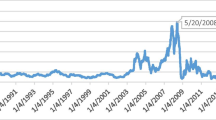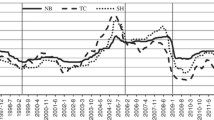Abstract
The dry bulk shipping market is a major component of the international shipping market and it is characterized by high risk and volatility, in view of the uncertainty caused by factors such as the global economy, the volume and pattern of seaborne trade, and government policies. In such markets, to model price behavior (of spot- or time charter rates) has always been a topic of great interest among researchers. This article makes an attempt to forecast spot rates at main routes for three types of dry bulk vessels and to find superior forecasting models that can provide better forecasts. In this article, 1-month change in the Baltic Index, representing the market sentiment, is firstly invented and incorporated into the forecasting models, and this indicator is found to be very helpful in improving prediction performance. Furthermore, some significant exogenous variables are also employed to improve forecasting performance. The results of the cointegration test reveal that there are no long-run relationships of spot prices between trading routes for all three ship sizes. Hence, except a vector error correction model, time series models, such as the ARIMA, ARIMAX, VAR and VARX, are employed in this article to make the prediction. All spot prices cover the period from January 1990 to December 2010, which is split into an estimation period and an out-of-sample forecasting period. In order to test whether the market since 2003 is significantly different from the market before, the in-sample estimation is made over two sample periods. Various models are estimated firstly over the whole period from January 1990 to June 2009, and then estimated again over the second period from January 2003 to June 2009 at all routes for three ship sizes. The period from July 2009 to December 2010 is then used to evaluate independent out-of-sample forecasts. The forecasting performance of various forecasting models is evaluated and the comparison of the forecasting capabilities between various models provides useful information in the selection of superior forecasting models, which can yield better forecasting results.



Similar content being viewed by others
Notes
The majority of Capesize vessels are engaged in the transportation of iron ore, mainly from Brazil and Australia, and also coal from Australia and South Africa. Panamax ships are used for iron ore exports from Brazil and Australia, coal exports from North America and Australia, grain exports from North America and Argentina, as well as bauxite and phosphate. Handymax/Handy vessels are used to transport grains from North America and Argentina to Africa and West Europe as well as minor bulks from all over the world.
References
Batchelor, R., Alizadeh, A. and Visvikis, I. (2007) Forecasting spot and forward prices in the international freight market. International Journal of Forecasting 23 (1): 101–114.
The Balitic Exchange (2010) www.baliticexchange.com, accessed 3 February 2011.
Beenstock, M. and Vergottis, A. (1993) Econometric Modelling of World Shipping, 1st edn. London, UK: Chapman and Hall.
Bierens, H.J. (1987) ARMAX model specification testing, with an application to unemployment to the Netherlands. Journal of Econometrics 35 (1): 161–190.
Box, G.E.P. and Jenkins, G. (1970) Time Series Analysis, Forecasting and Control. San Francisco, CA: Holden-Day.
Clements, M.P. and Hendry, D.F. (2001) Structural Change and Economic Forecasting, Unpublished typescript, Economics Department, University of Oxford.
Cullinane, K. (1992) A short-term adaptive forecasting model for BIFFEX speculation: A Box-Jenkins approach. Maritime Policy and Management 19 (2): 91–114.
Dickey, D. and Fuller, W. (1981) Likelihood ratio statistics for autoregressive time series with a unit root. Econometrica 49 (4): 1057–1072.
Franses, P.H. (1991) Primary demand for beer in the Netherlands: An application of ARMAX model specification. Journal of Marketing Research 28 (2): 240–245.
Greene, W.H. (1990) Econometric Analysis. New York: Macmillan Publishing Company.
Hampton, M.J. (1990) Long and Short Shipping Cycles. Cambridge, UK: Cambridge Academy of Transport, 2nd version, p. 2, pp. 40–49.
Harvey, A.C. (1990) The Econometric Analysis of Time Series. Cambridge, MA: MIT Press.
Jarque, C.M. amd Bera, A.K. (1980) Cointegration and error correction: representation, estimation, and testing. Econometrica 55 (2): 251–276.
Johansen, S. (1988) Statistical analysis of cointegration vectors. Journal of Economic Dynamics and Control 12: 231–254.
Kavussanos, M.G. and Nomikos, N.K. (1999) The forward pricing function of the shipping freight futures market. Journal of Futures Markets 19 (3): 353–376.
Kavussanos, M.G. and Nomikos, N.K. (2003) Price discovery, causality and forecasting in the freight futures market. Review of Derivatives Research 6 (3): 203–230.
Ljung, M. and Box, G. (1978) On a measure of lack of fit in time series models. Biometrika 65 (2): 297–303.
Lu, J., Marlow, P.B. and Wang, H. (2008) An analysis of freight rate volatility in dry bulk shipping markets. Maritime Policy and Management 35 (3): 237–251.
OANDA, http://www.oanda.com/currency/, accessed 16 March 2011.
Phillips, P.C.B. and Perron, P. (1988) Testing for a unit root in time series regressions. Biometrika 75 (2): 335–346.
Schwarz, G. (1978) Estimating the dimension of a model. Annals of Statistics 6 (2): 461–464.
Sims, C. (1980) Macroeconomics and reality. Econometrica 48 (1): 1–48.
Strandenes, S.P. (1984) Price Determination in the Time Charter and Second Hand Markets. Discussion paper 0584, Norwegian School of Economics and Business Administration, Bergen, Norway.
Tinbergen, J. (1959) Tonnage and freight. In: L.H. Klaassen L.M. Koyck and H.J. Witteveen (eds.) Jan Tingergen Selected Papers. Amsterdam, the Netherlands: North-Holland Publishing Company.
Wergeland, T. (1981) Norbulk: A Simulation Model of Bulk Freight Rates. Norwegian School of Economics and Business Administration, Working paper no. 12.
Zannetos, Z. (1966) The Theory of Oil Tankship Rates. Boston, MA: MIT Press.
Acknowledgements
We wish to thank the editor and two anonymous referees for their extremely valuable comments and suggestions.
Author information
Authors and Affiliations
Appendices
Appendix A
Appendix B
The equations of the forecasting errors, including RMSE, MAE and Theil's, can be seen as follows:



where
- T :
-
=the estimation sample size
- h :
-
=the number of the out-of-sample forecasts
- y t :
-
=observed value for month t
- ŷ t :
-
=predicted value for month t
Rights and permissions
About this article
Cite this article
Chen, S., Meersman, H. & Voorde, E. Forecasting spot rates at main routes in the dry bulk market. Marit Econ Logist 14, 498–537 (2012). https://doi.org/10.1057/mel.2012.18
Published:
Issue Date:
DOI: https://doi.org/10.1057/mel.2012.18




